
What Is a Medical Device Recall?
A medical device recall is a crucial regulatory action that removes or corrects distributed medical devices that violate FDA laws or may present a risk of injury or gross deception to users. For medical device manufacturers, understanding recall procedures isn’t just regulatory knowledge—it’s essential business protection that can save companies millions in costs and preserve market reputation.
The Three Classes of Medical Device Recalls
The FDA categorizes medical device recalls into three distinct classes based on the level of health hazard:
Class I Recalls
Most serious: Situations where there is reasonable probability that using the device will cause serious adverse health consequences or death. Examples include pacemakers with defective leads or surgical instruments that break during procedures.
Class II Recalls
Moderate risk: Situations where using the device may cause temporary or medically reversible adverse health consequences, with remote probability of serious harm. This includes software glitches in diagnostic equipment or labeling errors.
Class III Recalls
Lowest risk: Situations where using the device is not likely to cause adverse health consequences, typically involving minor labeling issues or cosmetic defects that don’t affect device functionality.
Voluntary vs. FDA-Mandated Recalls
Most medical device recalls (approximately 95%) are initiated voluntarily by manufacturers who identify problems through post-market surveillance, customer complaints, or internal quality investigations. However, the FDA can mandate recalls under Section 518(e) of the Federal Food, Drug, and Cosmetic Act when manufacturers fail to act voluntarily.
Voluntary recalls demonstrate proactive compliance and often result in better regulatory relationships, while mandated recalls can trigger additional FDA scrutiny and enforcement actions.
The Recall Process: Step-by-Step
- Problem Identification: Issue discovered through complaint handling, post-market surveillance, or quality investigations
- Risk Assessment: Evaluate potential health hazards using ISO 14971 risk management principles
- FDA Notification: Contact FDA within 24 hours for Class I recalls, 10 days for others
- Recall Strategy Development: Create detailed plan including affected lot numbers, distribution lists, and corrective actions
- Customer Notification: Issue recall letters with specific instructions for device return or correction
- Effectiveness Monitoring: Track recall progress and report to FDA regularly
- Recall Termination: FDA approval required once recall objectives are met
Critical Actions for Manufacturers
Immediate Response Protocol
- Establish a recall team with defined roles and responsibilities
- Document all recall-related decisions and communications
- Preserve evidence of the root cause and corrective actions
- Coordinate with insurance providers and legal counsel
Long-term Compliance Strategies
- Robust Post-Market Surveillance: Implement comprehensive systems per ISO 13485 requirements
- Complaint Handling: Establish efficient processes for identifying trends that could indicate recall-worthy issues
- Supplier Management: Ensure component suppliers have adequate quality controls
- Regular Risk Assessments: Continuously evaluate device safety throughout the product lifecycle
Financial and Business Impact
Medical device recalls can cost manufacturers between $1-10 million depending on the scope and device type. Beyond direct costs, recalls can impact stock prices, damage brand reputation, and result in increased FDA oversight. However, swift, transparent recall management often preserves customer trust and demonstrates commitment to patient safety.
Key Takeaways
Medical device recalls are an inherent part of the healthcare landscape, but manufacturers who invest in robust quality systems, proactive post-market surveillance, and recall preparedness can navigate these challenges successfully. The key is viewing recalls not as failures, but as opportunities to demonstrate commitment to patient safety and regulatory excellence.
Remember: effective recall management starts long before a recall occurs—it begins with comprehensive quality management systems and proactive risk management throughout your device’s lifecycle.


No comments yet. Be the first to comment!